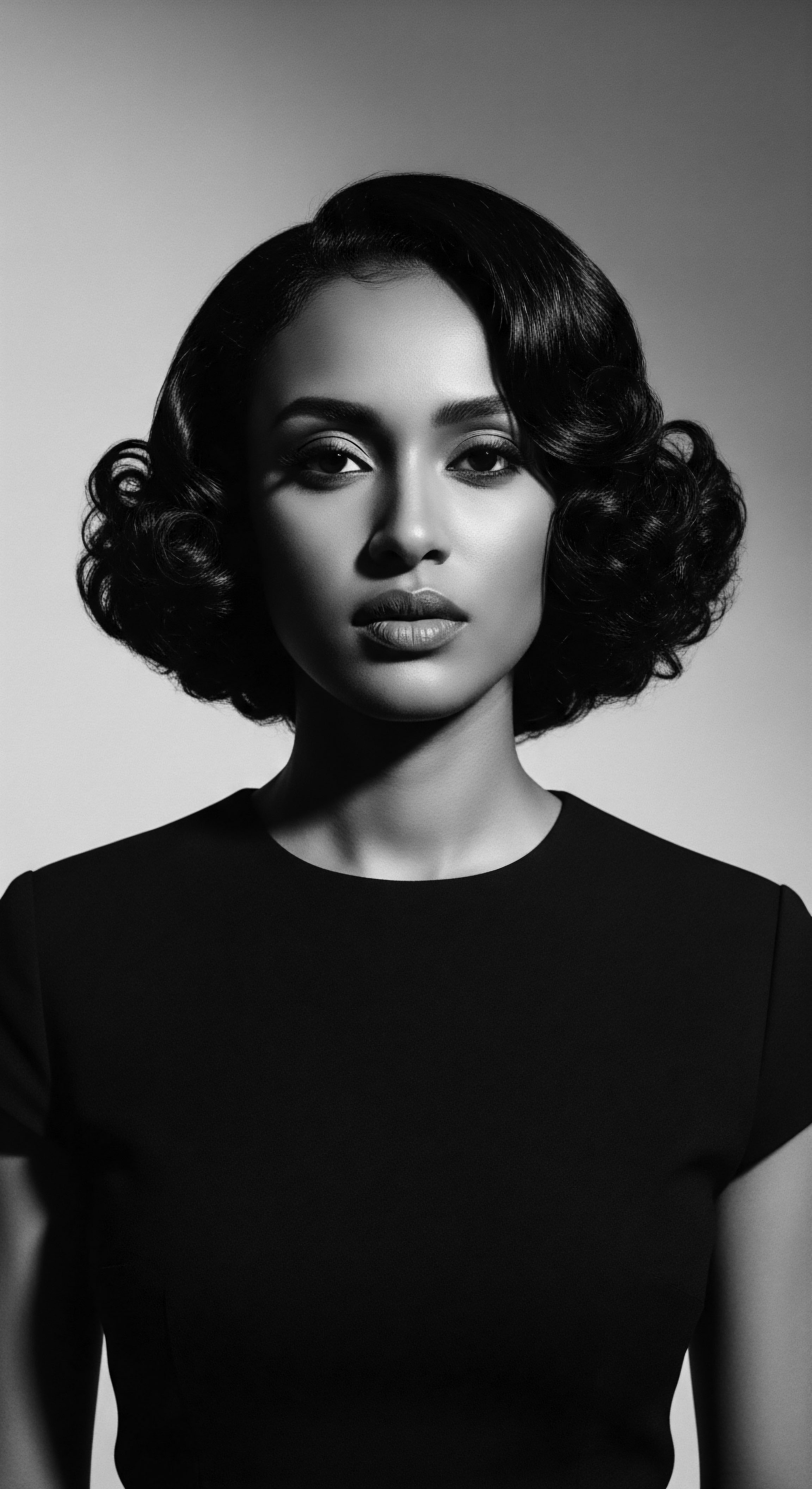
Fundamentals
The conversation surrounding textured hair often begins with visible attributes ❉ the curl pattern, the density, the shine. Beneath this vibrant display, however, lies the textured hair follicle , a foundational biological structure whose distinct form dictates the very character of each strand. Understanding this elemental biological unit is crucial for comprehending the inherent beauty and unique care requirements of coily, kinky, and wavy hair. This microscopic entity, situated within the scalp, is the very birthplace of hair, shaping its journey from creation to growth.
A hair follicle, in its most basic understanding, is a small, pouch-like invagination of the skin, a living factory where hair is produced. For all hair types, it comprises several key components ❉ the dermal papilla, which receives nourishment; the hair matrix, where cells rapidly divide to form the hair shaft; and the sebaceous gland, producing oils that condition the strand. However, the meaning of the textured hair follicle extends beyond this simple anatomical description. It embodies a biological distinction that yields the rich spectrum of hair textures observed across Black and mixed-race ancestries.
The fundamental explanation of a textured hair follicle rests on its unique shape and angle. Unlike straight hair, which typically emerges from a round, symmetrically shaped follicle, textured hair springs from an elliptical or oval-shaped follicle. This particular contour causes the hair shaft to grow in a curvilinear, spiraling path as it emerges from the scalp.
The degree of ellipticity in the follicle directly influences the tightness of the curl or coil, dictating whether hair forms soft waves, springy curls, tight coils, or intricate kinks. Moreover, the angle at which the follicle emerges from the scalp also plays a role, often lying flatter against the skin, contributing to the characteristic volume and intricate patterns of textured hair.
This biological blueprint, while seemingly a simple fact, carries generations of stories. The distinct delineation of the textured hair follicle reminds us that the hair it produces is not a deviation from a norm, but a natural, beautiful variation, a testament to humanity’s rich genetic diversity. From the earliest communal gatherings around the fire, where mothers and aunties shared wisdom on tending to the tender scalp and nascent curls, an understanding of this unique growth pattern, however unscientific in its phrasing, was intrinsically known. They knew the hair sought moisture, that it held patterns, and that gentle manipulation preserved its strength.
The textured hair follicle, an elliptical marvel nestled within the scalp, defines the inherent beauty and intricate patterns of coily, kinky, and wavy hair, a biological inheritance steeped in ancestral wisdom.
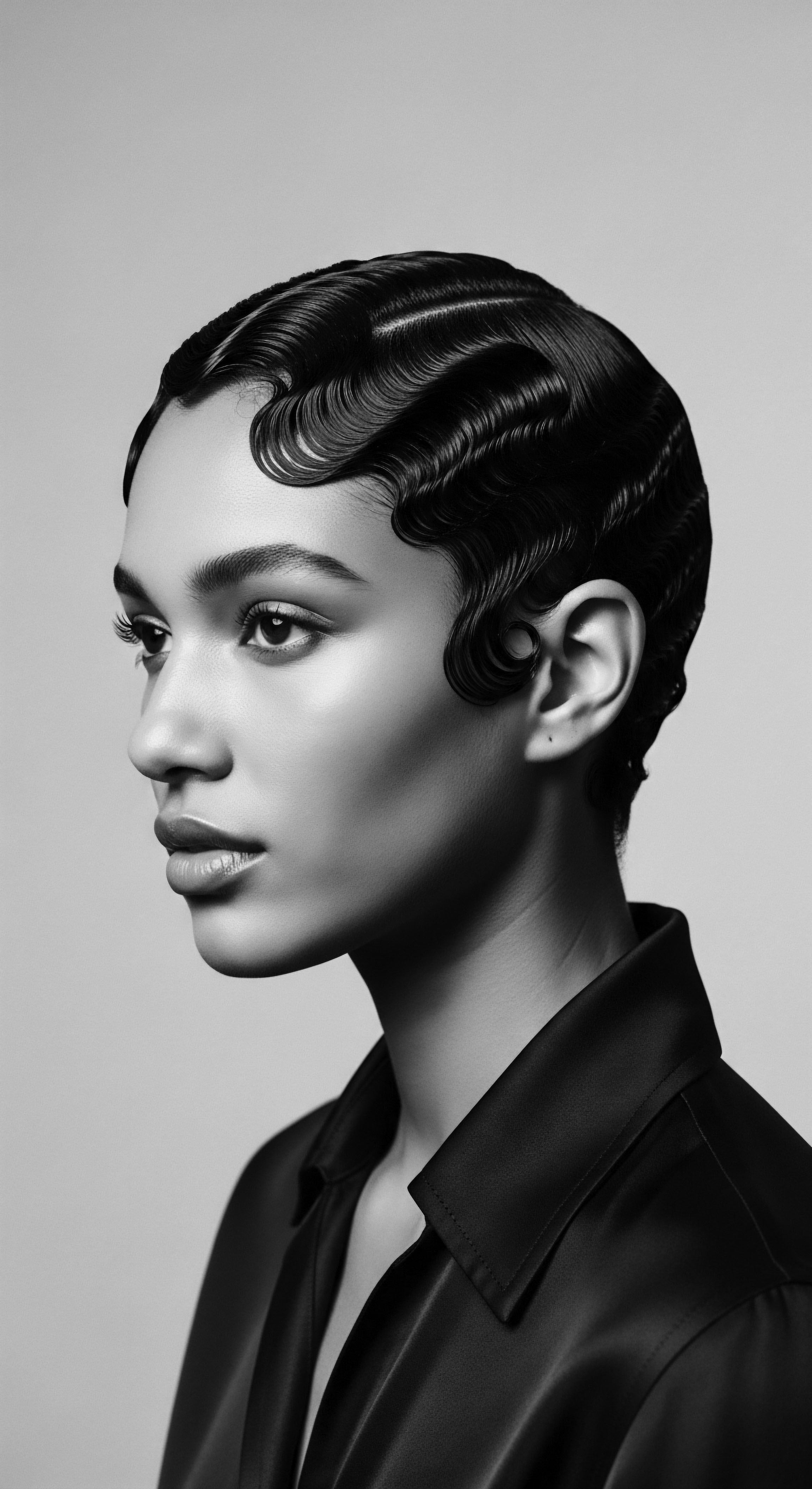
The Seed of Identity ❉ Early Perceptions
Early societies, particularly across African civilizations, held profound reverence for hair, viewing it not just as an adornment, but as a direct connection to spiritual realms and a reflection of social standing. The very act of tending to hair, often involving intricate styles that emerged directly from the natural growth patterns produced by these unique follicles, became a communal ritual. This understanding, while not expressed in scientific terms, acknowledged the specific needs of textured hair, recognizing its thirst for moisture and its inherent strength when properly nurtured.
The care of textured hair, therefore, became an ancestral practice woven into the very fabric of daily life. Natural elements—shea butter derived from karité trees, various plant-based oils, and clays—were intuitively employed to moisturize and protect the hair emerging from these distinct follicles. These were not merely cosmetic applications; they were expressions of care, respect, and a deep appreciation for the hair’s natural form. This foundational awareness of the textured hair follicle’s unique qualities, even without advanced microscopy, shaped traditions that prioritized its health and celebrated its aesthetic diversity.
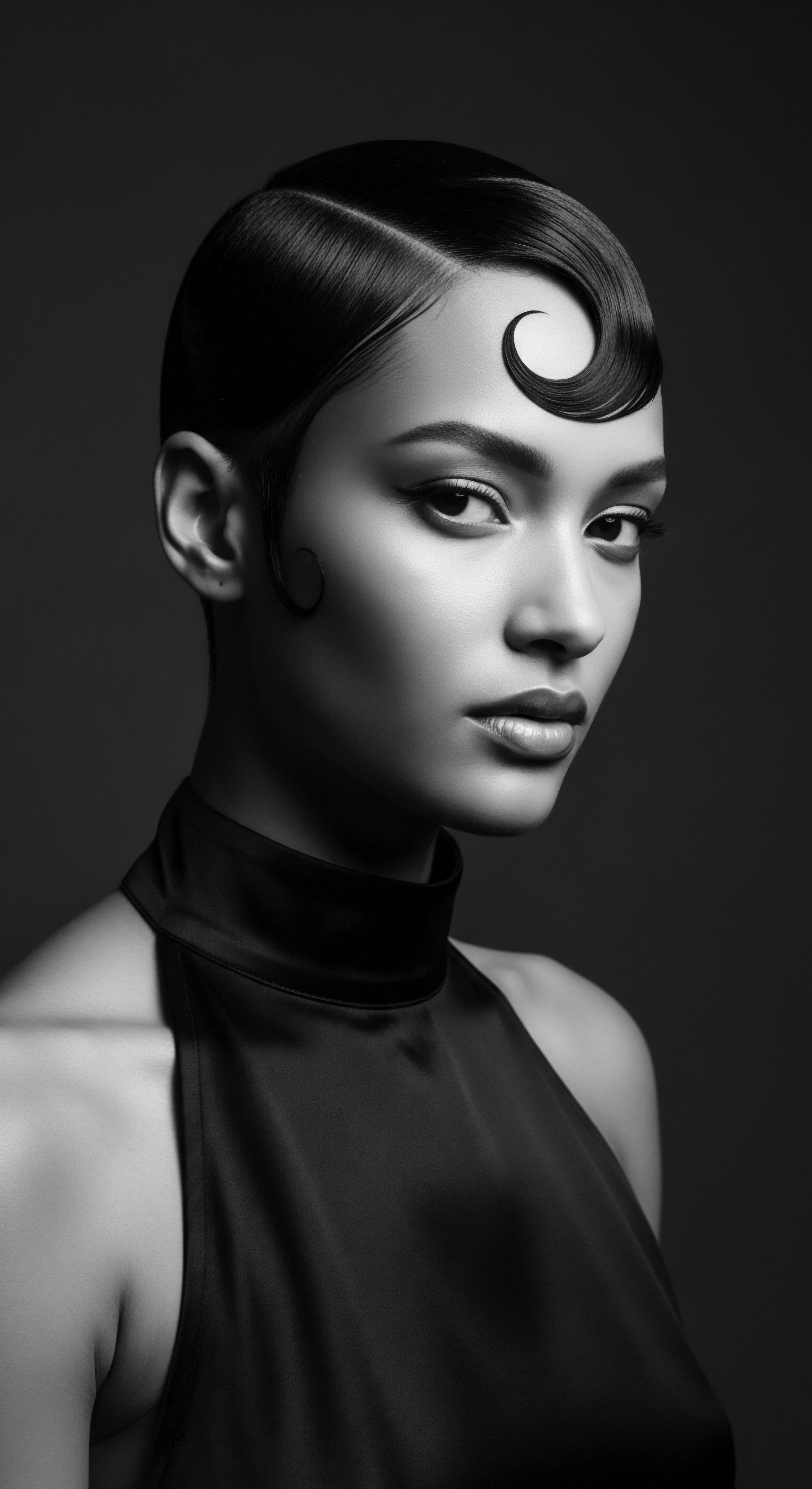
Intermediate
Moving beyond the foundational understanding, the interpretation of the textured hair follicle becomes more nuanced. Its physical configuration dictates how light reflects off the hair, how easily moisture escapes, and how fragile the strands can be if not handled with conscious care. This deeper exploration reveals not only the inherent biological characteristics but also the long historical and societal implications tied to this specific hair type. The elliptical shape of the follicle means the hair shaft is not uniformly round; it possesses flatter points, making it more prone to tangling and breakage at the points where the curl bends most acutely.
The helical pathway of growth, intrinsic to the hair emanating from a textured hair follicle, creates numerous points where the hair can interlock upon itself, forming those characteristic coils and kinks. While this structure contributes to the stunning volume and versatility of textured hair, it also presents challenges, particularly regarding moisture retention and detangling. The natural oils produced by the sebaceous glands, while vital for lubrication, struggle to travel down the spiraling shaft as effectively as they would on a straight strand. This inherent specification of the follicle leads to hair that tends to be drier, requiring a more intentional approach to hydration and gentle manipulation.

Ancestral Wisdom and Hair’s Hidden Language
Long before scientific instruments could dissect the morphology of a follicle, ancestral communities possessed a profound, intuitive grasp of how to nurture hair emerging from these unique structures. In various West African cultures, hair was far more than an accessory; it was a living map of identity, social status, and spiritual connection. The intricate description of a person’s life could often be read in their hairstyle, a testament to the versatility and expressive capacity of hair produced by the textured follicle.
According to historian Dr. Tameka Ellington, in West Africa, hairstyles could communicate a person’s marital status, religion, age, ethnic identity, wealth, and rank within the community.
The act of braiding, twisting, and oiling hair was not merely a chore; it was a communal ritual, a time for storytelling, education, and strengthening familial bonds. These practices, passed down through generations, implicitly understood the hair’s need for protection from environmental stressors and its yearning for deep moisture.
| Ancestral Practice African Threading (e.g. "Irun Kiko" by Yoruba people) |
| Significance for Textured Hair Follicles A technique using thread to stretch and protect hair, minimizing tangles and breakage, thereby aiding length retention. This practice directly addresses the tendency of textured hair to knot and shrink, preserving the integrity of the hair shaft emerging from the follicle. |
| Ancestral Practice Natural Oils and Butters (e.g. Shea butter, Coconut oil, Marula oil) |
| Significance for Textured Hair Follicles Applied to lubricate and seal moisture into the hair, compensating for the natural difficulty of sebum traveling down coily strands. These emollients provide a protective barrier for the cuticle layers emanating from the follicle, reducing dryness and susceptibility to damage. |
| Ancestral Practice Protective Styles (e.g. Braids, Twists, Cornrows) |
| Significance for Textured Hair Follicles These styles minimize daily manipulation and exposure to harsh elements, safeguarding the delicate hair shafts and the follicles themselves from stress. They prevent breakage and allow for growth, honoring the inherent characteristics of hair originating from textured follicles. |
| Ancestral Practice Chébé Powder (from Chad) |
| Significance for Textured Hair Follicles Used to promote length retention by filling hair shaft spaces and sealing the cuticle. It was often mixed with moisturizing substances and applied to braided hair, thereby fortifying the strands and promoting healthy growth from the follicle. |
| Ancestral Practice These ancient practices represent a deep, intuitive understanding of textured hair's unique biological needs, providing blueprints for modern care that respect its ancestral lineage. |

The Weight of Perception ❉ Hair and Societal Norms
The journey of the textured hair follicle through history has not been without its trials. During the transatlantic slave trade, one of the first acts of dehumanization was often the forced shaving or covering of enslaved Africans’ hair. This brutal act severed a deep connection to cultural identity and spiritual significance, aiming to erase their heritage.
As textured hair grew back in these unfamiliar lands, without access to traditional tools or ingredients, enslaved individuals improvised, using what was available – pig fat, axle oil, or even repurposed farm tools for grooming. These acts, while born of necessity, illustrate extraordinary resilience and a persistent desire to preserve a semblance of self and cultural connection, even under the most oppressive circumstances.
Post-emancipation, the legacy of this dehumanization persisted, manifesting in societal pressures to conform to Eurocentric beauty standards. Straight hair became synonymous with “good hair,” a prerequisite for social acceptance and economic opportunity. This historical context provides a critical lens through which to view the present-day struggles against hair discrimination, which still impacts individuals with textured hair in workplaces and schools globally. The inherent meaning of the textured hair follicle became unfortunately intertwined with societal judgments, creating a pervasive bias.
The textured hair follicle, a symbol of heritage and resilience, has endured centuries of societal pressure and discrimination, its unique structure shaping both personal identity and broader cultural narratives.
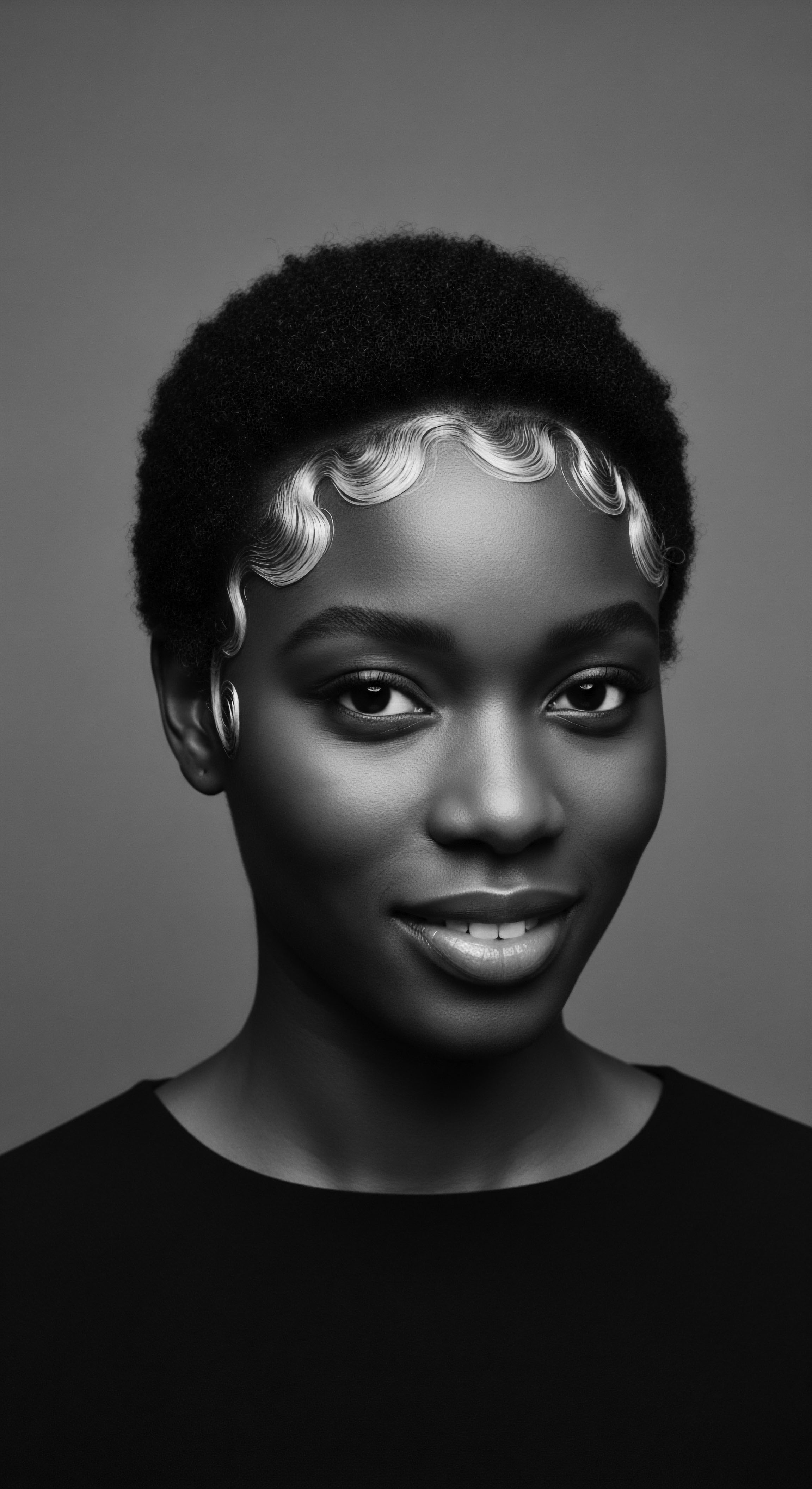
Academic
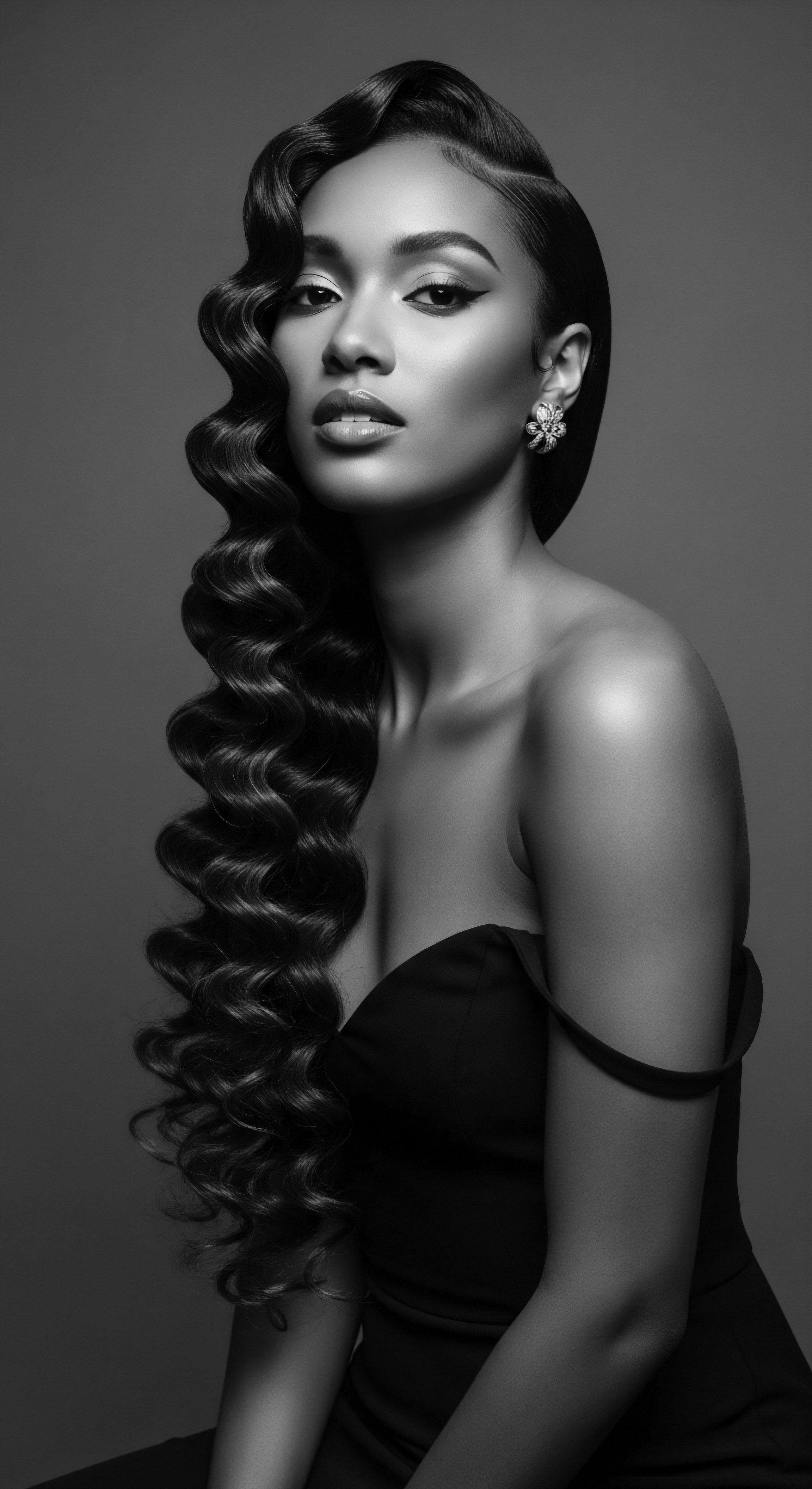
Defining the Textured Hair Follicle ❉ A Comprehensive Examination
The textured hair follicle represents a complex biological and cultural nexus, a micro-anatomical structure whose morphology fundamentally governs the macro-expression of hair phenotype, particularly the intricate coiling and kinking observed in hair types commonly associated with African and diasporic populations. Its comprehensive definition transcends mere biological description, encompassing its profound historical, sociological, and identity-affirming significance . From a rigorous academic vantage, the textured hair follicle is delineated as a specialized epidermal appendage characterized by an elliptical or flattened cross-sectional shape of its epithelial sheath.
This distinct geometry, coupled with an often acute angle of emergence from the scalp, compels the keratinizing cells to form a hair shaft that is not uniformly cylindrical but rather ribbon-like or irregularly oval in cross-section. This unique cellular arrangement within the follicle’s matrix and subsequent differential keratinization along the shaft’s circumference produces the characteristic twists, bends, and spirals that define textured hair, yielding greater elasticity, volume, and inherent stylistic diversity compared to hair emerging from more circular follicles.
The explanation of its structural peculiarities points to the presence of asymmetrical cell division within the follicular bulb and uneven distribution of disulphide bonds within the hair cortex, phenomena directly influenced by the follicle’s shape. This structural asymmetry leads to differential growth rates along the hair shaft’s circumference, thereby dictating its coiling trajectory. Furthermore, the number and distribution of sebaceous glands relative to the hair shaft may also play a role in moisture distribution, often resulting in natural oils struggling to coat the entire length of the spiraling strand, contributing to the perceived dryness of textured hair. The clarification of these biophysical attributes is paramount for formulating targeted, efficacious care regimens that honor the hair’s natural inclinations rather than attempting to force its alteration.
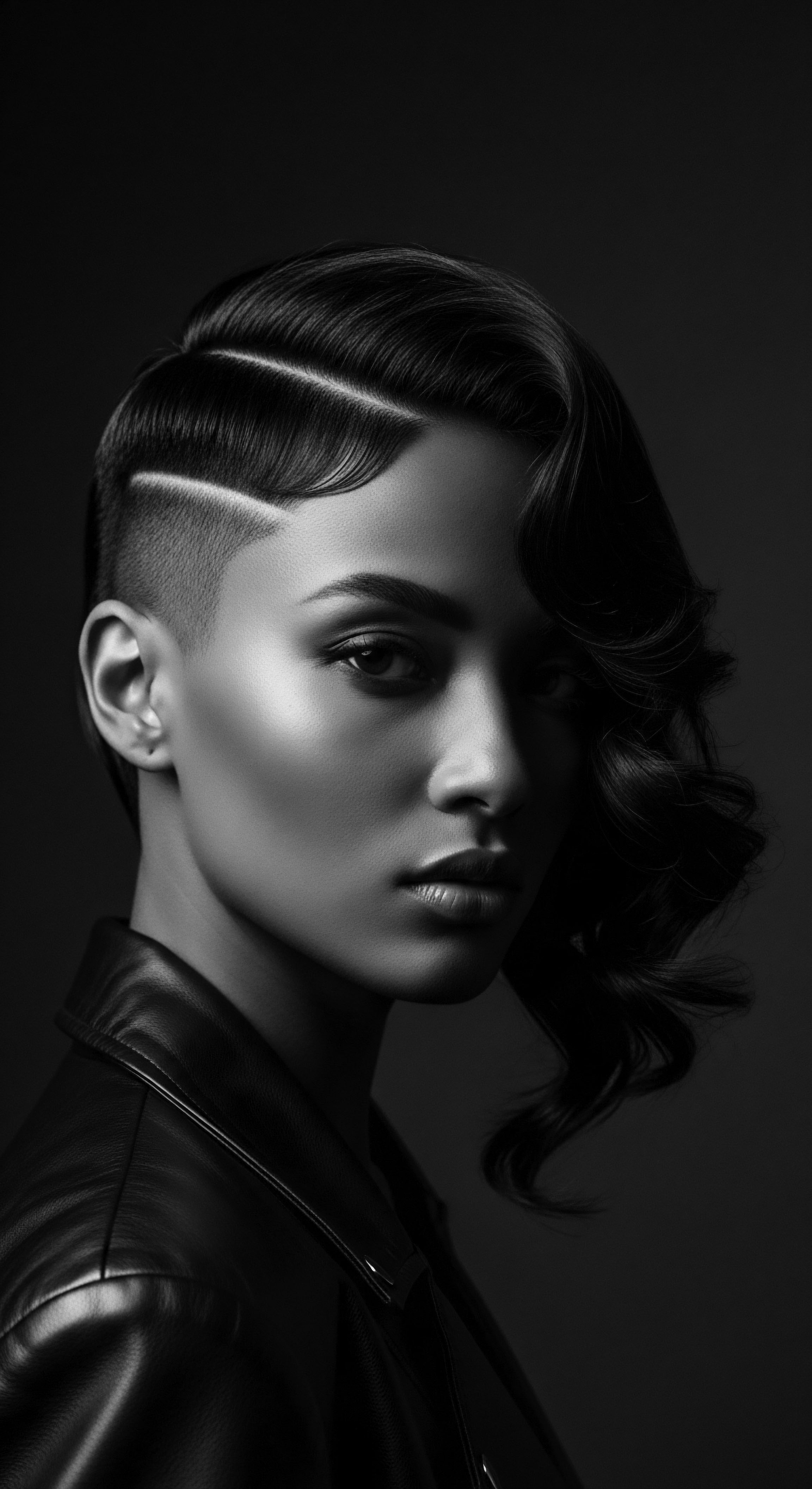
Microscopic Architecture and Genetic Predispositions
An in-depth exploration of the textured hair follicle reveals intricate cellular and molecular underpinnings. The dermal papilla, a cluster of mesenchymal cells nestled at the base of the follicle, orchestrates hair growth by interacting with surrounding epithelial cells of the hair matrix. In textured hair, these interactions, influenced by specific genetic markers, result in the aforementioned elliptical shaping. Research suggests that variations in genes related to hair follicle development and keratin production contribute to the diverse spectrum of curl patterns.
For instance, specific single nucleotide polymorphisms (SNPs) within genes like EDAR and FGFR2 have been correlated with hair thickness and curl type across various populations, indicating a complex polygenic inheritance pattern that dictates the precise designation of an individual’s textured hair follicle. The very existence of such diverse hair types is a testament to human genetic adaptation over millennia, each reflecting unique evolutionary pathways.
The journey of a hair strand from the follicle to its visible form is a continuous process of keratinization, where cells produced in the matrix harden and die, forming the protein-rich hair shaft. In textured hair, this process is influenced by the asymmetrical distribution of specific types of keratin and associated proteins, leading to differential tension along the developing strand and causing it to twist. The resulting coils create natural tangles, which, while sometimes challenging, also provide a remarkable structural integrity and resistance to breakage when properly hydrated. This intricate ballet of cellular mechanics within the textured hair follicle gives rise to a fiber that is both strong and delicate, resilient and requiring thoughtful attention.

The Follicle as a Site of Resistance and Identity ❉ A Historical Lens
The textured hair follicle, beyond its biological specification , carries profound historical and sociological weight, particularly within the narrative of Black and mixed-race experiences. Historically, the visible manifestation of hair from these follicles—its texture, volume, and natural inclination to coil—became a potent marker of racial identity. This visibility, tragically, rendered it a target during periods of systemic oppression.
Consider the insidious practice during the transatlantic slave trade and its aftermath, where the inherent differences in hair texture were weaponized to create a cruel caste system within enslaved populations. Historical accounts indicate that enslaved individuals with hair textures that more closely resembled European hair were often granted “privilege,” such as being assigned to domestic work within the master’s house, a perceived elevation from the brutal field labor typically endured by those with kinkier, more tightly coiled hair. This horrific differentiation, based on a biological trait originating from the follicle, systematically devalued and brutalized individuals based on their very physical being, leaving an enduring scar on the collective memory of hair. This was a deliberate act of dehumanization, stripping away identity and fostering internal divisions within communities.
Moreover, the very act of hair care during slavery transformed into a subversive ritual. Stripped of their traditional grooming tools and ancestral ingredients, enslaved Africans improvised, using readily available substances like animal fats, cooking oils, and even axle grease to condition their hair and scalps. They continued to braid and style hair, often in secret, not merely for hygiene or aesthetics, but as a silent act of resistance, a means of preserving cultural memory, and even, as some historians suggest, a way to convey messages or map escape routes through intricate braiding patterns. This demonstrates the enduring spirit that recognized the hair, originating from the textured hair follicle , as a vital connection to their ancestral homeland and identity, even in the face of unspeakable cruelty.
The fight for acceptance of textured hair continues into modern times. A telling example of this ongoing struggle is documented in the 2016 “Good Hair” Study by the Perception Institute. This comprehensive research revealed that, on average, white women show explicit bias toward Black women’s textured hair, rating it as less beautiful, less sexy/attractive, and less professional than smooth hair. Furthermore, the study determined that the majority of participants, regardless of race, exhibited implicit bias against Black women’s textured hair.
This powerful statistic underscores the pervasive nature of hair discrimination, highlighting how deeply ingrained societal biases about hair texture persist, affecting perceptions of professionalism and beauty, and often compelling Black women to alter their natural hair to conform. The Dove study (2019) further corroborated this, reporting that Black women are 3.4 times more likely to be labeled unprofessional due to hair presentation and 1.5 times more likely to be sent home from work citing “unprofessional hair.” (Dove, 2019, cited in) This data unequivocally demonstrates that the hair emerging from the textured follicle remains a site of contention in contemporary society, even as movements strive for natural hair acceptance.
The inherent bias against textured hair, revealed in studies like the “Good Hair” Study, underscores the pervasive societal pressures faced by Black women whose natural hair, born from its unique follicle, is often deemed less professional.

Ancestral Wisdom Validated by Modern Science
The deep understanding of hair care practices passed down through generations within Black and mixed-race communities often finds validation in modern scientific inquiry into the textured hair follicle. Ancient African beauty rituals, such as the use of natural oils like shea butter and marula oil, were employed for their nourishing and protective qualities. Science confirms that these emollients, rich in fatty acids and vitamins, help to seal the cuticle of the hair shaft, preventing moisture loss from the porous, coily structure. This reduces breakage and supports hair growth, which is particularly beneficial for hair emerging from the elliptical follicle.
Moreover, traditional techniques such as African hair threading, known as “Irun Kiko” among the Yoruba people, which involves wrapping hair with thread, served a practical purpose ❉ to stretch hair, reduce tangles, and protect it from damage. From a scientific perspective, this practice minimizes mechanical stress on the delicate hair shaft and cuticle, preventing the microscopic damage that can occur during styling or environmental exposure. This ancient method, therefore, acts as a sophisticated protective style that safeguards the hair’s integrity from the point of emergence from the follicle.
The use of Chébé powder, originating from Chad, which women apply to their hair to aid length retention by strengthening the hair shaft, represents another ancient practice with verifiable benefits. These ancestral practices demonstrate an intuitive, empirical understanding of how to optimize the health and length of hair produced by the textured hair follicle, long before the advent of biochemical analysis.
The movement to embrace natural hair, particularly since the Civil Rights era with the rise of the Afro, and its contemporary resurgence, represents a powerful reclamation of identity, self-acceptance, and resistance against Eurocentric beauty standards. This cultural shift has driven scientific interest in formulating products that truly cater to the unique needs of the textured hair follicle and the hair it produces, moving away from harsh chemical straighteners that historically damaged both hair and scalp.
- Follicle Shape and Hair Health ❉ The elliptical shape of the textured hair follicle is a biological distinction that creates hair prone to dryness and breakage due to its numerous bends. This anatomical reality necessitates a higher emphasis on moisture retention and gentle handling in care routines.
- Cuticular Integrity ❉ The cuticle of textured hair, with its raised scales, can be more susceptible to external damage. Ancestral practices involving natural oils and protective styles worked to smooth and seal these cuticles, validating a holistic approach to preserving hair strength.
- Scalp Health and Growth ❉ A healthy scalp environment is paramount for optimal follicular function. Traditional remedies and regular cleansing with natural ingredients, like Rhassoul clay, ensured the scalp remained free from buildup, fostering a healthy environment for hair growth from the textured follicle.
- Genetic Diversity ❉ The diverse forms of textured hair found globally are a testament to human genetic diversity, emphasizing that variations in follicle morphology are natural and should be celebrated rather than culturally suppressed.

Reflection on the Heritage of Textured Hair Follicles
As we stand at the crossroads of ancient wisdom and unfolding scientific discovery, the textured hair follicle reminds us of a profound truth ❉ that beauty is as diverse as the human spirit, and heritage pulses through every strand. This microscopic seed, nestled within the scalp, has silently borne witness to generations, carrying stories of resilience, cultural ingenuity, and a defiant beauty that refused to be extinguished. Its very formation speaks to a legacy of natural variation, a deep connection to ancestral lands where its unique characteristics served a purpose in harmony with the environment.
From the ceremonial braiding circles where knowledge flowed like liquid gold between generations, to the covert acts of self-preservation enacted during the darkest chapters of history, the care for hair born from the textured follicle has always been an act of love, of resistance, and of identity affirmation. The whispers of ancestors guide our hands as we apply nourishing butters and oils, instinctively tending to the thirst of each coil and kink, echoing rituals performed millennia ago. This enduring dialogue between past and present is a beautiful testament to the power of embodied knowledge, recognizing that the sophisticated care for textured hair is not a modern invention but a continuous thread in a long, celebrated story.
The journey from elemental biology to profound cultural symbol culminates in our present moment, where understanding the textured hair follicle empowers individuals to embrace their natural crowns with pride and reverence. It is a call to acknowledge the profound connections between our physical selves and our ancestral roots, to appreciate the innate wisdom of our bodies, and to honor the living, breathing archive that is textured hair. The textured hair follicle stands as a gentle yet powerful reminder that true beauty is found in authenticity, in the celebration of difference, and in the unbroken lineage of care that binds us to those who came before. It truly represents the soul of a strand, ever reaching, ever connecting.

References
- Ayana Byrd and Lori L. Tharps, Hair Story ❉ Untangling the Roots of Black Hair in America.
- Tameka Ellington, Natural Hair.
- Perception Institute, The Good Hair Study Results.
- Dove, The Dove 2019 CROWN Research Study.
- White-Jolivette, Tammy. “African American Women’s Experience of Wearing Natural Textured Hair.” Walden University Research.
